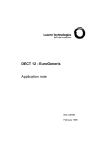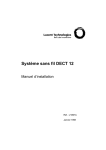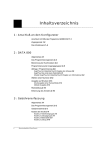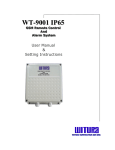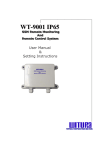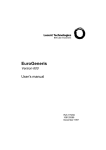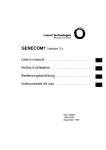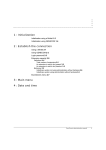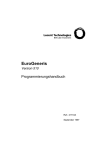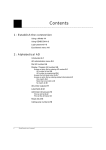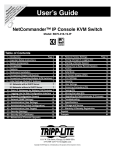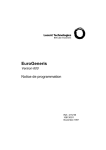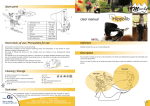Download Radio extension
Transcript
DECT 12 cordless system Installation manual Ref 21797A January 1998 Contents 1 : System components Radio hub 1-2 Radio extension 1-2 Cordless phone 1-3 2 : System configuration Deparmental application 2-1 3 : System planning Call handover 3-1 Cell planning 3-1 Range planning 3-3 4 : System installation Installing the radio hub 4-1 Wiring the radio hub 4-2 Connecting the ISDN BRI 1 4-3 Connecting the ISDN BRI 2 4-3 Using a junction box 4-4 Connecting the radio extensions 4-4 Connecting the power supply 4-5 Installing the radio extensions 4-5 Wiring the radio extensions 4-6 5 : System start-up System initialization 5-1 Cordless phone registration 5-1 Register the first cordless phone 5-1 Register additional cordless phones 5-2 i DECT12 Installation manual 6 : System administration Local administration 6-1 Remote administration 6-1 7 : Additional information Characteristics 7-1 Dimensions 7-1 Weight 7-1 Technical data 7-1 Power supply 7-1 Mains 7-1 Auxiliary 7-1 Capacities 7-1 Performance and range 7-2 Environmental conditions 7-2 Safety precautions 7-2 ii DECT12 Installation manual 1 System components The package includes: • The radio hub with - the external power supply - the 2 ISDN linking cables • The radio extensions. • The cordless handsets with - the chargers - the User’s manual. EuroGeneris extensions Trunks EuroGeneris DECT 12 S0 S0 Radio Hub 1-1 DECT12 Installation manual Radio extensions Cordless phones 1 System components Radio hub Radio hub The radio hub conforms to the Digital Enhanced Cordless Telecommunications standard. The radio hub has: • two external telephone lines for direct connection to ISDN BRI trunks (in standalone applications) or S0 ports of an existing PBX (in departmental applications), • two U interfaces for connecting external radio extensions, • a V24 interface allowing connection of a PC for local administration or a printer for CDR data records. Radio extension The radio extensions conform to the Digital Enhanced Cordless Telecommunications standard. The radio extensions provide the radio link to the cordless phones and are controlled by the radio hub. The system has a maximum capacity of 3 radio extensions, one of them being integrated into the radio hub, the other two being external. The radio extensions are not suitable for direct connection to EuroGeneris or direct exchange lines. 1-2 DECT12 Installation manual System components Cordless phone Cordless phone The WT9001 cordless phones conform to the Digital Enhanced Cordless Telecommunications standard. The system has a maximum capacity of 12 cordless phones. DECT12 Installation manual 1-3 1 1-4 System components Cordless phone DECT12 Installation manual 2 System configuration There are several ways in which the system can be configured, dependent upon individual requirements. Deparmental application EuroGeneris extensions Trunks EuroGeneris DECT 12 S0 S0 Radio Hub Radio extensions Cordless phones The radio hub is connected to EuroGeneris and offers two incoming/outgoing ISDN BRIs through EuroGeneris, providing extended cordless coverage. This type of installation is suitable for users with a requirement for cordless communications. 2-1 DECT 12 Installation manual 2 2-2 System configuration Deparmental application DECT 12 Installation manual 3 System planning The coverage area of a single radio extension is defined as a cell. This range is typically between 25 metres (inside buildings) to 300 metres (open area) dependent upon the environment. In some applications, however, a single radio extension will not offer complete coverage. Additional radio extensions can extend the coverage area and increase (up to 8) the number of simultaneous radio connections. Calls automatically use the best radio extension and as a user moves throughout the coverage area the call is automatically transferred between radio extensions (handover). A zone is a number of radio extensions with overlapping or non-overlapping cells that operate in a co-ordinated way to give extended cordless coverage. Call handover The system uses call handover to transfer calls from one radio extension to another, allowing cordless phone users to move freely within the system coverage area without loosing the call. Call handover occurs transparently between radio extensions with overlapping coverage. However, this is dependent upon the required radio extension being available. Cell planning It is important that the radio extensions are installed so that they offer optimum coverage. This section gives guidelines on how to estimate the coverage in various typical environments. The radio signal from a radio extension is generated equally in a circular pattern, offering uniform coverage. 1. Whenever possible, site a radio extension in a central position in the required coverage area. 2. Radio extensions should be installed at a minimum height of 1.5 metres above 3-1 DECT12 Installation manual 3 System planning Cell planning ground level but sufficiently below ceiling height to avoid interference. Generally, a cell has a typical range of between 25 and 300 metres in any direction, depending upon various environmental factors. Because of this, the range achieved can vary considerably between one installation and another. Range is best when an unobstructed ‘line-of-sight’ path exists between a radio extension and a cordless phone. Barriers between a radio extension and cordless phone will reduce the coverage area by obstructing the radio signal. For example, range is reduced by glass, wood, brick or concrete. Transmission cannot take place at all through metal. Radio extensions are not weatherproof and should only be installed indoors. Damp environments must be avoided. Linear arrangement - overlapping Linear arrangement - overlapping & separate 3-2 DECT12 Installation manual System planning Range planning Angular arrangements - overlapping Range planning This section outlines a method of estimating the range of a single radio extension in a variety of environments. Typical cell range in an office environment is anticipated to be 25 to 80 metres. On this basis, to estimate the range of a single radio extension, proceed as follows: 1. Draw a site plan showing the position and type of all barriers. 2. Taking into account any practical considerations, such as mounting surfaces and access to mains power, estimate the site position of the first radio extension. DECT12 Installation manual 3-3 3 System planning Range planning 3. Use the following diagrams and tables to calculate radio coverage. 100 ...300m 30m 50m 20m 30m Building with plasterboard walls Building with stone walls Building with reinforced concrete walls Two-storey building KEY 3-4 DECT12 Installation manual plasterboard stone reinforced concrete System planning Range planning Width/Length of building (m) Number of walls 100 90 80 70 60 50 40 30 20 10 19 15 13 11 9 7 5 3 1 One-storey building Type of wall Up to 4 cordless phones plasterboard 17 Recommended number of radio extensions • • 3 stone 3 2 2 2 1 1 1 • • 3 2 2 1 1 • • 3 2 1 3 2 2 2 2 2 2 • • 3 2 2 2 2 • • 3 2 2 reinforced concrete Up to 8 cordless phones plasterboard • • 3 stone reinforced concrete Up to 12 cordless phones plasterboard • stone reinforced concrete Two-storey building Type of wall Up to 4 cordless phones plasterboard • 3 3 3 3 3 3 3 3 • • 3 3 3 3 3 • • 3 3 3 Recommended number of radio extensions • stone • 2 1 1 • • 2 2 • • 2 • 2 2 2 • • 2 2 • • 2 • 3 3 3 • • 3 3 • • 3 reinforced concrete Up to 8 cordless phones plasterboard • stone reinforced concrete Up to 12 cordless phones plasterboard stone reinforced concrete • • Signal strength measurement is recommended. Please note that the above figures are given for guideline purposes only. They should be used by the system planner to understand and then estimate the coverage given by the radio extensions and the number of radio extensions required for an installation. It is strongly recommended that prior to installation, on-site trials using the radio extensions and a cordless phone with a signal strength meter are carried out to verify the cordless performance of the system. DECT12 Installation manual 3-5 3 3-6 System planning Range planning DECT12 Installation manual 4 System installation Installing the radio hub Important: Do not connect the radio hub to the mains supply or ISDN/host PBX until the installation is complete. The radio hub is designed to be wall-mounted. Proceed as follows: System wall-mounting template 260.1 mm ø 6 mm 245 mm ø 6 mm ø 6 mm • Remove the radio hub front cover. Note: Do not remove the inner cover which protects the system components. • Mark the position of the screw holes on the wall. Note: Make sure there is enough clearance around the system for ventilation purposes. • • • Drill the screw holes as marked and fit wall plugs. Insert three screws into the wall so that 5mm of screw and the screw head protrude beyond the wall plug. Hang the radio hub onto the screws to check that they have been mounted at the right height and distance. Important: Wire the radio hub and and thread the cables through the routing channels before you definitely mount it on the wall. • • 4-1 Hang the radio hub onto the screws and tighten the screws. Check that the radio hub is supported firmly on the wall on its mounting screws. DECT12 Installation manual 4 System installation Wiring the radio hub Wiring the radio hub All the cables should be threaded through the routing channels provided at the back of the radio hub. Routing channels All the connectors are located at the back of the radio hub. f e d c Ground (if necessary) 4-2 DECT12 Installation manual V24 interface Power supply - + - + ISDN BRI 2 ISDN BRI 1 Radio extensions System installation Wiring the radio hub Connecting the ISDN BRI 1 Connecting the ISDN BRI 1 • • Snap one end of the the supplied ISDN linking cable into the ‘S0-AMT’ jack at the back of the radio hub. Snap the free end of the supplied ISDN linking cable into the appropriate S0 jack on EuroGeneris. DECT 12 Radio hub EuroGeneris (ISDN BRI 1) Connecting the ISDN BRI 2 • Fix the insulated ends of the wires to the terminal block. Plug the terminal block into the ‘S0-AMT/S0-BUS’ connector on the back of the radio hub. Snap the 8-pin RJ 45 into the appropriate S0 jack on EuroGeneris. f e d c f e d c DECT 12 Radio hub (ISDN BRI 2) c f e d = Rx + = Rx – = Tx – = Tx + 3 4 5 6 • • EuroGeneris DECT12 Installation manual 4-3 4 System installation Wiring the radio hub Using a junction box Using a junction box If the DECT 12 system is located far from EuroGeneris, junction boxes will have to be used to connect the ISDN BRIs. These junction boxes should be sited as close as possible to the DECT 12 system. Two terminal resistors (100 Ohms) should be added. DECT 12 Radio hub (ISDN BRI 2) f e d c f 1 2 3 c 4 d 5 e 6 3 4 5 6 Junction box EuroGeneris Connecting the radio extensions • • Fix the insulated ends of the wires to the terminal blocks. Plug the terminal block into the ‘KE1’ and ‘KE2’ connectors on the back of the radio hub. KE1 KE2 DECT 12 Radio hub - + - + Radio extensions 4-4 DECT12 Installation manual System installation Installing the radio extensions Connecting the power supply Connecting the power supply • Snap the free end of the external power supply into the RJ 45 jack on the back of the radio hub. • Plug the external power supply into the 230V wall socket. Installing the radio extensions The radio extensions are designed to be wall-mounted. Proceed as follows: Radio extension wall-mounting template 120 mm ø 6 mm • ø 6 mm Mark the position of the screw holes on the wall. Note: Make sure there is enough clearance around the system for ventilation purposes. • Drill the screw holes as marked and fit wall plugs. DECT12 Installation manual 4-5 4 System installation Wiring the radio extensions Connecting the power supply • • Insert three screws into the wall so that 5mm of screw and the screw head protrude beyond the wall plug. Hang the radio extension onto the screws to check that they have been mounted at the right height and distance. Important: Wire the radio extension and and thread the cable through the routing channel before you definitely mount it on the wall. • • Hang the radio extension onto the screws and tighten the screws. Check that the radio extension is supported firmly on the wall on its mounting screws. Wiring the radio extensions • • 4-6 Fix the insulated ends of the wires to the terminal blocks. Plug the terminal block into the connectors on the back of the radio extensions. DECT12 Installation manual 5 System start-up System initialization The intitialization process takes about one minute once the system is powered up. When system initialization is successful, the LEDs 1 and 2 in the inner cover of the radio hub slowly flash and the one located at the back of the radio extension flashes as well. ❶ ❷ ❸ The system has been factory-set with a standard configuration. Cordless phone registration A maximum of 12 cordless phones may be registered on the system. Note: The cordless phones must be administered as DECT users before being registered. Register the first cordless phone The first cordless phone to be registered is the Asministrator phone. 1. Press the Menu button. 2. Press the Previous or Next button to select the «SET UP» feature. MENU: ok 3. Press the OK button. 5-1 DECT12 Installation manual <> SET UP ok <> 5 System start-up Cordless phone registration Register additional cordless phones 4. Press the Previous or Next button to select the «LOG IN» feature. BEEP=ON Off <> LOG IN ok <> At the radio hub, press the button located on the right-hand side Note: You have one minute to achieve the registration procedure. 5. At the cordless phone, press the OK button. 6. Enter “0000” (factory-setting) LOG IN! NO CODE ? ---- TEL. NO.: 390 ok <> 7. Press the OK button. 8. System name is displayed. LOGGED IN LUCENT 100% The Administrator cordless phone is ready for operation. Register additional cordless phones At the Administrator cordless phone: 1. Press the ON/OFF HOOK button. 2. Press the Menu button. PLEASE DIAL >Call list MENU: <Tel. System> 3. Press the Previous or Next button to select the «SET-UP MENU». 5-2 DECT12 Installation manual System start-up Cordless phone registration Register additional cordless phones 4. Press the OK button. SET-UP MENU ok <> REGISTER HANDSET ok <> 5. Press the OK button. 6. Enter “0000” (factory-setting) BOOK: PIN ? ---- BOOK IN ok <> 7. Press the OK button twice. CODE NO.: 7915 Book in CODE NO.: 7915 PERFORM LOGIN At an additional cordless phone: Note: You have one minute to achieve the registration procedure. 8. Press the Menu button. 9. Press the Previous or Next button to select the «SET UP» feature. MENU: ok <> SET UP ok <> 10. Press the OK button. 11. Press the Previous or Next button to select the «LOG IN» feature. BEEP=ON Off <> LOG IN ok <> 12. Press the OK button. 13. Enter the 4-digit code displayed by the system at the administrator phone. CODE NO.? ---- TEL. NO.: 391 ok <> 14. Press the OK button. 15. System name is displayed. LOGGED IN LUCENT 100% The additional cordless phone is ready for operation. Repeat the above steps for each cordless phone which requires registration on the system. DECT12 Installation manual 5-3 5 5-4 System start-up Cordless phone registration Register additional cordless phones DECT12 Installation manual 6 System administration System administration may be done locally or remotely. Local administration Local administration is done by means of a PC equipped with the administration software and connected to the radio hub V24 interface. Remote administration Remote administration may be done: • through DECT 12 integrated modem (V110) using the ISDN network, EuroGeneris DECT 12 ISDN S0 ISDN modem • through an external modem (V23/V32) using the analog public telephone network. S0 DECT 12 EuroGeneris Analog PTN Analog line External modem 6-1 DECT12 Installation manual Analog modem 6 6-2 System administration Remote administration DECT12 Installation manual 7 Additional information Characteristics Dimensions Radio hub: 349 x 296 x 56 mm (WxHxD) Radio extension: 215 x 179 x 61 mm (WxHxD) Cordless phone: 54 x 151 x 30 mm (WxHxD) Weight Radio hub / Radio extension: approx. 2Kg Cordless phone: approx. 180g Technical data Power supply Mains Radio hub / Radio extension: 230V (+6% -10%) - 43VA Cordless phone: 230V (+6% -14%) - 5.3VA Auxiliary Radio hub / Radio extension: • 40V - 18.4VA • 20V - 8VA • 45V - 2.7VA Cordless phone: 7.5V - 1.2VA Capacities The system supports: • Two U-interfaces for external radio extensions (700m maximum distance using 2wire, 0.6mm diameter cable) • One V24 interface for PC (maximum distance 10m) • Up to 12 cordless phones • Up to 4 simultaneous calls per radio extension and a maximum of 8 simultaneous calls for the system. 7-1 DECT12 Installation manual 7 Additional information Environmental conditions Performance and range Performance and range Since the system uses a radio link, it may occasionally suffer from interference or reduced range due to adverse operating conditions. Typical range is between 25 and 300 metres. A number of factors affect this but range will be best when an unobstructed “line-of-sight” exists between the cordless phone and the radio extension. Range is somewhat reduced by glass or wood and more severely by brick, stone or concrete. Transmission cannot take place through a metal obstacle. Moving position usually overcomes these problems. Environmental conditions Temperature: +5° to +40°C Humidity: class 3.1 Air conditioning: not required Safety precautions The radio hub and radio extensions are not weatherproof and should only be installed indoors. Avoid installing them in any areas where they may be exposed to damp, humidity, condensation and chemicals. In all cases, they should be installed far enough from any metal surface or electrical device to avoid interference. Disconnecting the mains supply is recommended before installing and wiring operations are carried out. Safety levels f e d c SELV - + - + TNV TNV TNV SELV = Safety extra low voltage - TNV = Telecommunications network voltage. 7-2 DECT12 Installation manual Additional information Safety precautions Performance and range DECT12 Installation manual 7-3 7 7-4 Additional information Safety precautions Performance and range DECT12 Installation manual BCS Service Documentation Technique ZI Saint Lambert • 49412 SAUMUR CEDEX • FRANCE Ce document n’est pas contractuel. Le constructeur se réserve le droit d’apporter toutes les modifications qu’il jugera utiles, sans préavis. The information in this document is subject to change without notice. The manufacturer assumes no responsibility for any errors that may appear in this document.



































